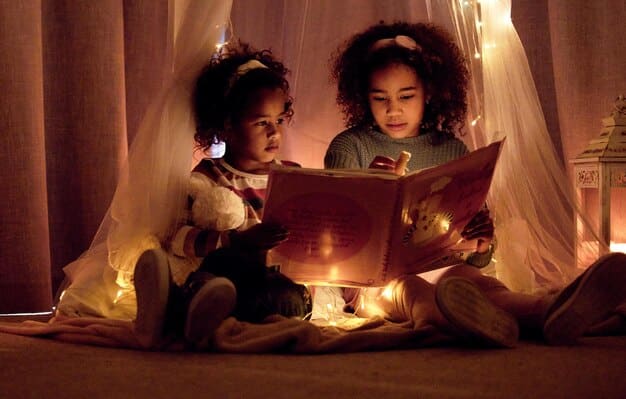Middle Grade’s Enduring Appeal: Themes & Styles for Young Readers

The enduring appeal of middle grade literature lies in its authentic exploration of universal themes such as identity, friendship, and resilience, presented through accessible narratives and diverse writing styles that genuinely resonate with young readers navigating pivotal developmental years.
Delving into the captivating world of literature tailored for young minds, one genre consistently stands out for its profound impact and timeless charm: middle grade. The Middle Grade’s Enduring Appeal: Exploring the Themes and Writing Styles That Resonate with Young Readers isn’t merely about age-appropriate content; it’s about a nuanced understanding of a crucial developmental stage, reflected in narratives that speak directly to the experiences, aspirations, and challenges of pre-teens.
The Defining Characteristics of Middle Grade Literature
Middle grade literature occupies a unique and vital space in the literary landscape, specifically catering to readers typically aged 8 to 12. This demographic, often referred to as “tweens,” is at a fascinating crossroads of development, transitioning from early childhood to adolescence. Understanding the core characteristics of this genre is essential to appreciating its enduring appeal.
One of the primary hallmarks of middle grade books is their focus on protagonists who are themselves in this age range. These characters embark on journeys of self-discovery, navigate complex social dynamics, and confront challenges that, while significant to them, are generally not life-or-death scenarios. Unlike young adult (YA) literature, discussions of romantic love are rare or peripheral, with emphasis placed more on friendships, family relationships, and personal growth.
Age-Appropriate Content and Themes
The content in middle grade books is carefully curated to be age-appropriate, meaning it avoids overt violence, explicit language, and mature sexual themes. Instead, it tackles weighty subjects in a way that is sensitive and digestible for younger readers, fostering understanding and empathy without overwhelming them. This thoughtful approach allows authors to address real-world issues while maintaining a sense of hope and adventure.
- Universal Experiences: Stories often center on relatable experiences like starting a new school, dealing with bullies, or feeling like an outsider.
- Emotional Growth: Characters learn about themselves and the world through their struggles, developing resilience and self-awareness.
- Problem-Solving: Protagonists typically solve their own problems, fostering a sense of agency and empowerment in young readers.
The narratives are often driven by a clear plot, offering a sense of direction that is comforting and engaging for this age group. While fantastical elements are common, the emotional core of the story remains grounded in reality, reflecting the internal world of a pre-teen. This balance between adventure and introspection is key to its attractiveness.
Ultimately, middle grade literature serves as a crucial bridge for young readers, preparing them for more complex narratives while celebrating the unique intricacies of their developmental stage. It’s a genre that respects its audience, offering stories that are both entertaining and deeply meaningful.
Themes That Resonate: Identity, Friendship, and Belonging
At the heart of middle grade literature’s lasting impact are the universal themes it explores, particularly those revolving around identity, friendship, and the quest for belonging. These are not niche topics but fundamental aspects of the human experience, especially poignant during the formative years of 8 to 12.
The journey of discovering oneself is a cornerstone of many middle grade narratives. Protagonists grapple with who they are, what they believe in, and where they fit in the world. This often manifests through internal monologues, character choices, and challenges that force them to examine their values. Authors excel at portraying this internal struggle in an accessible way, allowing young readers to see reflections of their own nascent identities within the pages.
Navigating Friendships and Social Dynamics
Friendships are paramount in middle grade books, often serving as the primary relationship dynamic. Stories frequently depict the highs and lows of forming bonds, dealing with fallouts, and understanding loyalty and betrayal. These narratives provide a safe space for young readers to explore the complexities of social interactions without the weight of real-world consequences, offering valuable lessons in empathy and communication.
- Loyalty and Trust: Characters learn the importance of being a good friend and how to trust others.
- Conflict Resolution: Friends encounter disagreements, offering models for constructive problem-solving.
- Inclusivity: Many stories promote acceptance and understanding of different backgrounds and perspectives within friendships.
The theme of belonging, whether within a family, a group of friends, or a community, is equally vital. Characters often feel like outsiders or struggle to find their place, a common sentiment among pre-teens. The narrative arc frequently involves the protagonist finding their “tribe” or coming to terms with their individuality, emphasizing that belonging can mean being true to oneself.
These themes are not presented didactically but woven seamlessly into engaging plots, often through fantasy, adventure, or realistic fiction. The subtle exploration of these weighty subjects allows young readers to process complex emotions and situations, building their emotional intelligence and social awareness. The power of middle grade lies in its ability to validate their experiences while offering pathways to understanding and growth.
Crafting Engaging Narratives: Writing Styles and Structures
The success of middle grade literature in capturing and retaining young readers’ attention is heavily dependent on its unique writing styles and narrative structures. Authors in this genre employ specific techniques to ensure their stories are both compelling and comprehensible for their target audience.
A fundamental aspect is the use of clear, straightforward language. While vocabulary might expand and sentence structures become more complex than in early reader books, they remain accessible. Authors avoid overly convoluted syntax or abstract concepts that could deter a developing reader. This clarity ensures that the story’s momentum is maintained, keeping children immersed in the narrative.
Pacing and Plot Development
Pacing is critical in middle grade fiction. Stories tend to move at a brisk pace, with regular plot developments and cliffhangers at chapter ends to encourage continuous reading. There’s a balance between character development and plot progression, ensuring that readers are invested in both what happens and to whom it happens. Long descriptive passages are often minimized in favor of action or dialogue that drives the story forward.
- Intriguing Openings: Chapters typically start with an event or question that pulls the reader in immediately.
- Steady Incidents: Challenges and developments occur regularly to maintain interest.
- Satisfying Conclusions: While series might leave some questions, individual books often provide a sense of resolution.
First-person or close third-person perspectives are commonly used, allowing readers to deeply connect with the protagonist’s thoughts and feelings. This close viewpoint fosters empathy and makes the emotional journey of the character more immediate and relatable. The voice of the protagonist is often distinct, echoing the unique perspectives and humor of a young person.
Furthermore, middle grade authors often weave humor throughout their narratives. This can range from witty banter and situational comedy to more subtle ironic observations. Humor serves not only to entertain but also to lighten the mood when tackling serious themes, making the overall reading experience more enjoyable and less daunting. The combination of clear language, engaging pacing, and relatable voice is what truly makes middle grade narratives resonate.
The Role of Fantasy and Adventure in Middle Grade
While realistic fiction certainly thrives in middle grade, the enduring appeal of the genre is perhaps most powerfully showcased in its embrace of fantasy and adventure. These elements provide a rich canvas for exploring complex themes and allowing young readers to transcend the ordinary, fostering imagination and critical thinking.
Fantasy worlds in middle grade are often imaginative and expansive, but they remain grounded enough to resonate with the emotional experiences of the characters. Whether it’s a hidden magical world, a mythical creature, or a journey through time, these fantastical elements serve as more than just escapism. They frequently act as metaphors for real-world challenges, allowing authors to explore difficult topics through a veil of wonder. This approach can make daunting subjects more approachable for young readers.
Quests, Journeys, and Brave Protagonists
Adventure is inherently appealing to the middle grade age group, reflecting their burgeoning independence and curiosity about the world beyond their immediate surroundings. Stories often involve quests, perilous journeys, and challenges that test the protagonists’ courage, wit, and resilience. These adventures are typically driven by a clear goal, such as saving a friend, recovering a lost artifact, or uncovering a hidden truth.
- Character Development: Adventures force characters to confront their fears and discover inner strengths.
- Problem-Solving: Protagonists must use cunning and teamwork to overcome obstacles, promoting critical thinking.
- Exploration of Morality: Challenging situations often present moral dilemmas, encouraging readers to consider right and wrong.
The protagonists in these adventure stories, though young, are rarely passive. They are active participants in their own destinies, often making difficult decisions and facing consequences. This emphasis on agency empowers young readers, showing them that even small individuals can make a significant impact.

Furthermore, the blend of fantasy and adventure encourages a deeper engagement with the narrative. Readers are not just observing; they are often trying to solve puzzles alongside the characters, predict outcomes, and imagine themselves in similar thrilling situations. This active participation strengthens their comprehension skills and fosters a lifelong love for storytelling. The journey, both physical and emotional, is what makes these narratives truly unforgettable.
The Importance of Diverse Voices and Perspectives
In contemporary middle grade literature, the increasing emphasis on diverse voices and perspectives is not merely a trend but a crucial evolution, significantly contributing to the genre’s enduring appeal. When young readers encounter a broad spectrum of experiences, they develop a more nuanced understanding of the world and their place within it.
Diversity in middle grade extends beyond just racial or ethnic representation to include socioeconomic status, disability, gender identity, sexual orientation, family structures, and varying cultural backgrounds. Stories featuring characters from underrepresented groups provide vital mirrors for children who rarely see themselves in books, validating their experiences and building self-esteem. For other readers, these books serve as windows, fostering empathy and helping them to understand perspectives different from their own.
Validation and Empathy Through Representation
When a child sees a character who looks like them, speaks like them, or faces challenges similar to theirs, it communicates a powerful message: “You are seen, and your story matters.” This validation is invaluable during a developmental stage where identity formation is paramount. Moreover, reading about characters with different experiences can dismantle stereotypes and build bridges of understanding across cultural divides.
- Mirroring Experiences: Readers from diverse backgrounds find characters who reflect their lives, fostering self-acceptance.
- Widening Perspectives: All readers gain insights into unfamiliar cultures, lifestyles, and challenges, promoting empathy.
- Challenging Bias: Exposure to varied narratives can help to counteract unconscious biases and promote inclusivity.
Authors are increasingly crafting narratives that are authentic representations, often drawing battle, a character finding their voice, or a historical event seen through the eyes of a child. These stories encourage critical thinking and present complex subjects in a developmentally appropriate manner.
The commitment to diversity and inclusion enriches the entire genre. It ensures that middle grade literature remains relevant and impactful for a new generation of readers, helping them to navigate an increasingly interconnected world with greater understanding and compassion. This expanded landscape of voices is undeniably a pillar of its lasting charm.
Addressing Real-World Issues with Sensitivity
One of the most remarkable strengths of middle grade literature is its capacity to address real-world issues with profound sensitivity and insight. Unlike genres that might shy away from complex topics, middle grade authors skillfully weave challenging subjects into narratives that are both compelling and accessible for young readers, fostering emotional intelligence and resilience.
These issues can range from socio-economic disparities, bullying, anxiety, and grief, to environmental concerns, identity struggles, and family challenges like divorce or illness. The key is how these topics are presented. Authors never preach or simplify, but rather explore the emotional impact of these situations on young protagonists, often through their reactions, internal thoughts, and interactions with peers and adults.
Fostering Emotional Intelligence and Resilience
By engaging with characters who are navigating difficult real-world situations, young readers gain valuable tools for processing their own emotions and challenges. The stories provide a safe space to explore feelings like sadness, anger, fear, and confusion, validating these emotions as part of the human experience. Importantly, these narratives often show characters actively coping and developing resilience, rather than being overwhelmed by their circumstances.
- Empowerment: Characters learn to advocate for themselves and others, demonstrating agency in difficult situations.
- Coping Mechanisms: Stories model constructive ways to deal with stress, grief, or conflict.
- Promoting Dialogue: Reading about these issues can open up conversations between children and trusted adults.

The sensitivity comes from portraying these issues authentically, acknowledging their difficulty without resorting to overly dark or graphic descriptions. Solutions, when they come, are often hard-won and realistic, emphasizing effort and perseverance over magical fixes. This approach helps children build a realistic understanding of challenges and the importance of perseverance.
Moreover, middle grade books often feature supportive adults or peers who guide the protagonist through their struggles, providing examples of healthy support networks. This teaches readers the importance of seeking help and offering comfort to others. The masterful handling of real-world issues ensures middle grade literature remains relevant, offering not just entertainment, but crucial life lessons.
The Future of Middle Grade: Evolution and Continued Relevance
The dynamic world of publishing constantly evolves, and middle grade literature is no exception. As society changes, so too do the stories that resonate with young readers. The future of middle grade promises continued innovation, adapting to new challenges and embracing diverse forms, ensuring its enduring relevance for generations to come.
One clear trajectory for the genre is an even greater emphasis on intersectional diversity. Beyond surface-level representation, authors are digging deeper into the nuances of identity, exploring how various aspects of a character’s background intersect to shape their experiences. This will lead to richer, more complex characters and narratives that mirror the diverse realities of young readers.
Emerging Trends and Formats
The medium itself is also expanding. While traditional novels remain central, graphic novels are experiencing a booming presence in middle grade, offering unique storytelling opportunities through visual narrative. Hybrid formats, blending text with illustrations, continue to gain popularity, making reading accessible and engaging for a wider range of learners. Audiobooks also play an increasingly important role, providing another avenue for consumption.
- Digital Storytelling: Exploration of interactive narratives and transmedia elements that bridge books with online content.
- Global Perspectives: Increased translation and publication of middle grade literature from around the world, broadening cultural understanding.
- Climate Change and Social Justice: More narratives directly addressing pressing global issues, empowering young activists.
Furthermore, middle grade literature is likely to continue pushing boundaries in its thematic exploration. While maintaining age-appropriateness, authors will find new and sensitive ways to tackle complex social issues, mental health challenges, and the impact of technology on young lives. The goal will remain to provide guideposts for these pivotal years, reflecting the world young readers inhabit.
The collaboration between authors, educators, librarians, and parents remains vital in shaping this future. By collectively championing high-quality, relevant middle grade books, we ensure that this genre continues to be a powerful force in nurturing empathy, fostering literacy, and empowering the next generation of readers and thinkers. Its ability to grow and adapt is precisely what guarantees its lasting appeal.
| Key Aspect | Brief Description |
|---|---|
| 🧠 Identity & Growth | Characters explore who they are amidst relatable challenges, fostering personal development. |
| 🤝 Friendship Dynamics | Focus on bonds, conflicts, and loyalty within peer relationships. |
| ✍️ Accessible Storytelling | Clear language, engaging pacing, and relatable character voices. |
| 🌍 Diverse Perspectives | Inclusion of varied voices and experiences for empathy and understanding. |
Frequently Asked Questions About Middle Grade Literature
Middle grade literature is primarily written for readers aged 8 to 12, often referred to as “tweens.” This age range reflects a unique developmental stage where readers are transitioning from early childhood to early adolescence, seeking stories that mirror their evolving understanding of themselves and the world around them.
Middle grade books focus on protagonists typically aged 8-12 and generally avoid explicit romance, violence, or mature themes, emphasizing friendships, family, and personal growth. YA literature, for ages 13+, often features older protagonists, more complex romantic relationships, and delves into sophisticated social issues or challenges appropriate for a high school age group.
Common themes in middle grade literature include identity formation, navigating friendships and social dynamics, finding a sense of belonging, building resilience, and understanding family relationships. Authors often explore universal challenges like bullying, overcoming fears, and discovering one’s unique strengths, all presented in an age-appropriate and hopeful manner.
Diversity is crucial in middle grade books because it provides both mirrors and windows for young readers. Mirrors allow children to see themselves and their experiences validated in stories, fostering self-acceptance. Windows offer insights into different cultures and perspectives, building empathy and understanding for others, which is vital for navigating an interconnected world.
Middle grade novels typically feature clear, accessible language with an engaging, direct voice often from a close first-person or third-person perspective. The pacing is usually brisk, with consistent plot progression and cliffhangers to maintain reader interest. Authors frequently incorporate humor and maintain a sense of adventure, balancing realism with elements of fantasy or quest narratives.
Conclusion
The continued allure of middle grade literature is a testament to its profound understanding of its target audience. By expertly weaving themes of identity, friendship, and belonging into engaging narratives, employing accessible writing styles, and bravely addressing real-world issues with sensitivity, the genre consistently offers young readers not just entertainment, but crucial tools for navigating their formative years. It acts as a vital bridge in a child’s reading journey, fostering empathy, critical thinking, and a lifelong love for stories. As it evolves, embracing new formats and even greater diversity, middle grade literature stands as a powerful, enduring force in shaping thoughtful, compassionate, and resilient young minds.





